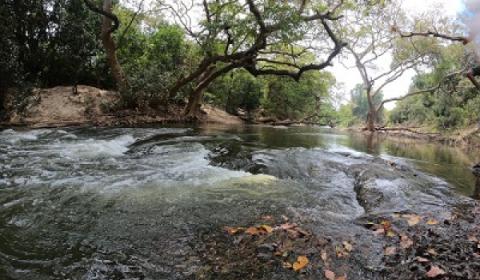Managing together: Integrating community-centered, ecosystem-based approaches into forestry, agriculture and tourism sectors
Project Background
Sri Lanka's biodiversity is globally significant both for its irreplaceability and its vulnerability. About 30% of the country's land area has been designated as protected, in a range of categories managed mainly by two government agencies, the Forest Department and the Department of Wildlife Conservation. It has long been recognized that protected areas are vital but not enough alone to conserve biodiversity and to maintain natural ecological processes. In particular, habitat modification through human activities in the surrounding landscapes and seascapes threatens the effectiveness of individual protected areas whether marine or terrestrial. Government agency policies, and the activities of people in different production and development sectors often conflict not only with biodiversity conservation, but also with each other.
The Project, “Managing Together: Integrating Community-centered, Ecosystem-based Approaches into Forestry, Agriculture and Tourism Sectors”, in short identified as “Managing Together” uses a community-centered and ecosystem-based approach to mainstream biodiversity conservation and benefit sharing through the development sectors of forestry, agriculture and tourism. The Project, which will be mainly based in the Malwathu Oya Basin, is led by the Biodiversity Secretariat of the Ministry of Environment with funding from the Global Environment Facility’s 6th programme cycle through UNDP, and IUCN as the responsible partner. The area includes major protected areas and significant populations of elephants and other globally significant species whose viability can only be ensured through such a coordinated approach. Although the access to this area was restricted during the 26-year civil war, tourists are now beginning to arrive to an area where tourist infrastructure is limited. The project provides a valuable opportunity to establish social and environmental safeguards in time to avoid repeating damaging mistakes in tourism development in the south of the country.
The Project will work with multiple stakeholders extending from national level government agencies to provincial and district administration to community level. Private sector engagement is a key aspect to enhance income levels and quality of life of communities who are safeguarding ecosystem services while using the same environment for tourism, agriculture, forestry, and other socio-economic activities. This four year project, commenced in 2021, aims to develop a number of up-scalable models for integrating conservation in development using three trial landscapes within the Malwathu Oya Basin—two terrestrial (Ritigala to Mihintale and Giant’s Tank/Madhu Road-Wilpattu) areas and one marine (Gulf of Mannar/Vankalai-Arippu-Silavaturai) area.
The Project will enhance the capacity of project partners and communities to engage in scientific land-use planning, business development, community development leading to enhanced income and improved ecosystems/ecosystem services in the area. In doing so, the Project will involve the community, government and private sector jointly in designing and developing innovative land-use practices, area-based products and services while mainstreaming biodiversity conservation for long-term sustainability and resilience. Project activities will be primarily implemented in the six “focal villages” in the three "trial landscapes", focusing mainly on agriculture, tourism, and forestry.
The long-term monitoring programme, which will be in operation will track the impacts of this landscape approach and will make necessary adjustments to develop up-scalable models based on results in the three "trial landscapes." A dissemination programme will be established to share results and to encourage adoption of the modified approach in other parts of the country.
Objectives of the project
Strengthened protection of globally significant biodiversity through mainstreaming of conservation and sustainable practices into land use planning and sectoral decision-making in forestry, agriculture and tourism sectors
Expected Outputs
Output 2.1: Public information and involvement programme designed and implemented across all Districts and Divisional Secretariats represented in the Trial Landscapes
Output 2.2: Mechanisms for trans-jurisdictional and multi-sectoral consultations in the landscape conservation design established and implemented
Output 2.3: Strategic conservation designs for each Trial Landscape for incorporation into government decision-making and local development plans
Output 2.4: Guidelines for mainstreaming biodiversity conservation into natural resource management, tourism and land use planning
Output 2.5: Technical and material support for immediate actions required under the agreed strategic designs
Output 3.1: Public information and involvement programme designed and implemented in the focal village clusters
Output 3.2: Participatory mechanisms to bring together community and government stakeholders in a landscape conservation design approach to local land use planning
Output 3.3: Biophysical and socio-economic information required for analysis and reference before and during community-centred land-use planning
Output 3.4: Six village cluster land-use plans that provide opportunities for novel or modified livelihoods linked with biodiversity conservation
Output 3.5: Livelihood interventions to enhance tourism and natural resource management under the land-use plans prepared and implemented
Donor/s: Global Environment Facility
Partner/s: Ministry of Environment, UNDP and IUCN

